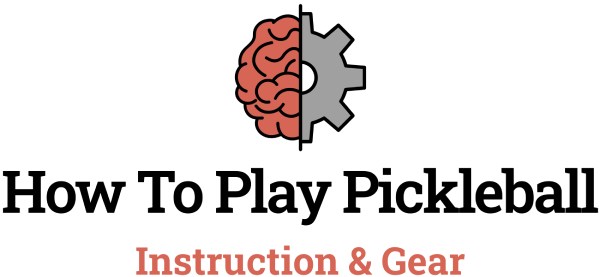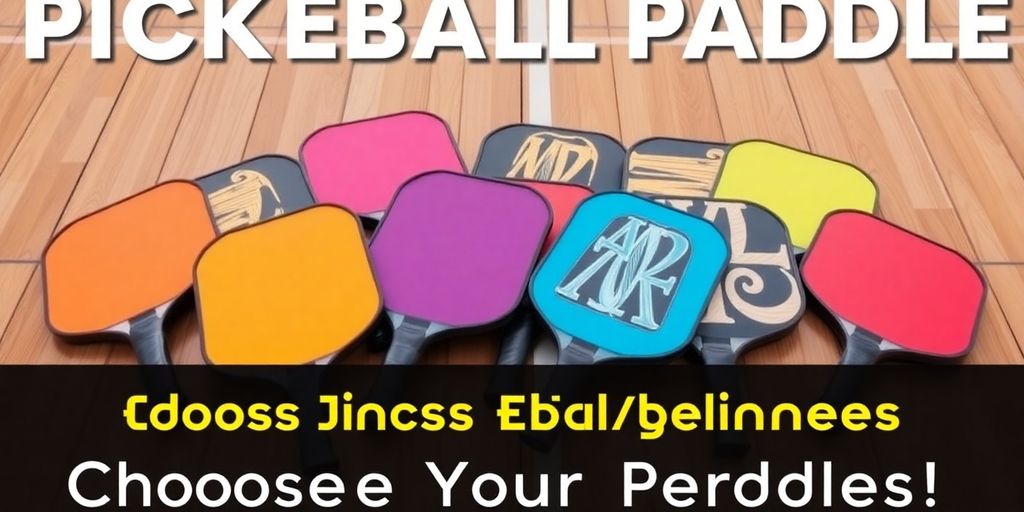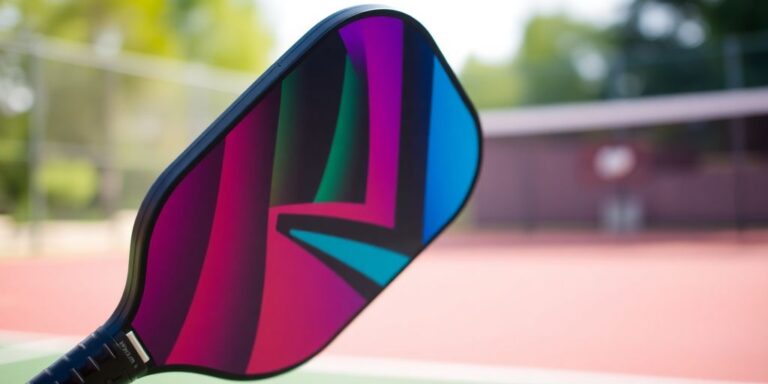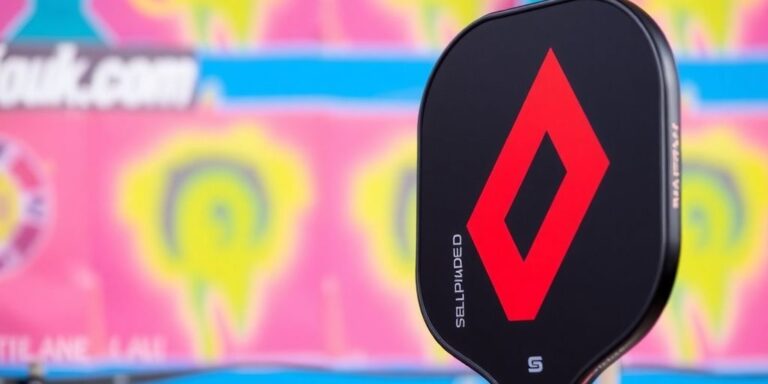If you’re just starting out in pickleball, choosing the right paddle is a big deal. It’s not just about picking something off the shelf. The right paddle can really change how you play and enjoy the game. With so many options out there, it can feel overwhelming to find the best pickleball paddles for beginners. This guide will help you understand what to look for and make the right choice for your first paddle in 2025.
Key Takeaways
- Picking the right paddle can boost your learning and enjoyment.
- Different types of paddles suit different play styles.
- Focus on weight, grip size, and core material for a good fit.
- There are great options for various budgets and play styles.
- Stay updated on the latest paddle technology for better performance.
Why Choosing The Right Beginner Paddle Matters
Choosing the right paddle when you’re starting out in pickleball is super important. It’s not just about grabbing any old paddle; it’s about finding one that fits you and helps you learn the game the right way. A good paddle can make a huge difference in how quickly you improve and how much fun you have.
Impact On Learning Curve
The right paddle can seriously speed up your learning process. Think of it like this: if you’re trying to learn to ride a bike, you wouldn’t start on a professional racing bike, right? You’d want something stable and easy to control. It’s the same with pickleball. A paddle that’s too heavy or has too small of a grip can make it harder to learn the basic strokes and techniques. A lighter paddle allows you to learn the skills and techniques you need more quickly. You’ll develop good habits from the start, and that’s going to pay off big time as you get better.
Enhancing Comfort And Control
Comfort and control are key, especially when you’re new to the game. You don’t want a paddle that’s going to tire you out after just a few minutes of playing. You also want to feel like you have a good grip and can control where the ball goes. A paddle with a comfortable grip size and a weight that feels good in your hand will make a big difference.
A paddle that feels good in your hand will allow you to focus on your technique and strategy, rather than being distracted by discomfort or struggling to control the paddle. This leads to a more enjoyable and productive learning experience.
Maximizing Enjoyment
Let’s be real, pickleball is supposed to be fun! If you’re struggling with a paddle that’s not right for you, you’re not going to have a good time. You might get frustrated, feel like you’re not improving, and even want to quit. But with the right paddle, you’ll be able to hit the ball more consistently, play longer without getting tired, and just generally have a better experience. This will keep you motivated to keep playing and improving. Plus, when you’re having fun, you’re more likely to stick with it and become a skilled pickleball player in the long run.
Types Of Pickleball Paddles

Okay, so you’re getting into pickleball. Awesome! One of the first things you’ll realize is that there are a TON of different paddles out there. It can be overwhelming, but let’s break down the main types you’ll encounter. Knowing this will help you choose the best pickleball paddle for your game.
Wooden Paddles
Let’s be real, wooden paddles are kind of the OGs of pickleball. They’re usually the most budget-friendly option, which is great if you’re just trying out the sport and don’t want to drop a ton of cash right away. However, there are some downsides. They tend to be heavier than other types of paddles, which can make them a bit harder to maneuver, especially for beginners. Also, they don’t offer as much control or power as composite or graphite paddles. Durability can also be an issue, as they’re more prone to warping or cracking over time. If you’re serious about improving your game, you’ll probably want to upgrade from a wooden paddle eventually, but they’re a decent starting point.
Composite Paddles
Composite paddles are a step up from wooden ones. They’re made from a combination of materials, like fiberglass or carbon fiber, layered over a core material. This construction gives them a good balance of power and control. They’re also generally lighter than wooden paddles, making them easier to swing and maneuver. Composite paddles are a popular choice for beginners because they offer a good all-around performance without breaking the bank. You’ll find that JOOLA 3S series paddles are a great option to consider.
Graphite Paddles
Graphite paddles are often considered the premium option. They’re made with a graphite or carbon fiber face, which is super lightweight and stiff. This gives them excellent control and responsiveness. Graphite paddles are great for players who want to have a lot of finesse in their game. They allow for precise shots and good ball placement. However, they can be more expensive than composite or wooden paddles. If you’re willing to invest a bit more, a graphite paddle can really help you elevate your game. They’re known for their durability, too, so you’ll likely get a lot of use out of them.
Choosing the right paddle is a personal thing. What works for one player might not work for another. It’s all about finding what feels comfortable and helps you play your best game. Don’t be afraid to try out different types of paddles before making a decision.
Key Features To Look For In Beginner Paddles
Weight Class
Okay, so weight is a big deal. You want something that feels good in your hand, not like you’re swinging a brick. For beginners, I’d suggest sticking with mid-weight paddles. They give you a nice balance of power and control. Too light, and you might not get enough oomph behind your shots. Too heavy, and you’ll tire out quickly. Mid-weight usually falls somewhere between 7.5 and 8.2 ounces. This range lets you develop your swing without straining your arm. It’s all about finding that sweet spot where you can react quickly and still put some mustard on the ball.
Grip Size
Grip size is another one of those things that can make or break your experience. If the grip is too small, you’ll be squeezing it too hard, which leads to fatigue and less control. Too big, and you won’t be able to get a good feel for the paddle. Here’s a quick guide:
- Measure from the tip of your ring finger to the bottom crease of your palm.
- That measurement in inches is roughly your ideal grip size.
- Most standard grips are around 4.25 inches, but you can always add an overgrip to make it thicker.
I remember when I first started, I didn’t pay attention to grip size at all. I just grabbed whatever paddle was available. Big mistake! My hand cramped up after just a few games. Once I switched to the right size, it was a game changer.
Core Material
The core of the paddle is where a lot of the magic happens. It affects how the paddle feels, how much power you get, and how forgiving it is. The most common materials you’ll see are:
- Polymer: This is a popular choice for beginners because it’s soft and provides good control. Composite pickleball paddles with polymer cores are also pretty quiet, which is nice if you’re playing in a noise-sensitive area.
- Nomex: Nomex cores are stiffer and offer more power, but they can be less forgiving on off-center hits. You might want to hold off on these until you’ve got a bit more experience.
- Aluminum: Aluminum cores are lightweight and offer a decent blend of power and control, but they’re not as common as polymer or Nomex.
For beginners, I usually recommend starting with a polymer core. They’re more forgiving and help you develop your technique without getting punished too badly for mishits. Also, look for a 16mm core, as it provides a larger sweet spot and better shock absorption. If you are looking for the best overall paddles, consider the core material and how it will affect your game.
Top Recommendations For Beginners

Okay, so you’re ready to get serious about pickleball! Picking the right paddle when you’re just starting out can feel overwhelming. There are a ton of options, but don’t sweat it. I’ve put together some recommendations to help you find a paddle that fits your game and your budget. Let’s dive in!
Best Overall Paddles
If you’re looking for a solid all-around paddle that will help you develop your skills, these are some great choices. These paddles offer a good balance of power, control, and forgiveness, making them ideal for learning the game.
- 11SIX24 Jelly Bean Series: This paddle is known for its large sweet spot and comfortable grip. It’s a great option for players who want a paddle that’s easy to control and forgiving on off-center hits. The 11SIX24 Jelly Bean is a great choice for beginners.
- Vatic Pro Prism Series: The Prism series offers a blend of power and control, with a textured surface that helps generate spin. It’s a good step up for players who want a paddle that can help them add some pop to their game. The Vatic Pro Prism is a popular choice.
- SLK Halo Control: This paddle is designed for players who prioritize control and accuracy. It has a soft core that provides excellent feel and helps absorb vibrations. It’s a great option for players who want to focus on placement and dinking.
Budget-Friendly Options
You don’t have to break the bank to get a good beginner paddle. There are plenty of affordable options that will allow you to learn the game without spending a fortune. Here are a few of my favorites:
- Niupipo Explorer Set: This set includes two paddles, balls, and a bag, making it a great value for beginners. The paddles are made with a polymer core and graphite surface, providing a good balance of power and control. It’s a great way to get started without a huge investment. You can find the best pickleball paddle for beginners in this set.
- Amazon Basics Pickleball Paddle: This paddle is a simple, no-frills option that’s perfect for casual players. It’s lightweight and easy to swing, making it a good choice for beginners who are still developing their technique.
- Paddletek Ranger: This paddle offers good performance at an affordable price. It has a polymer core and a textured surface that helps generate spin. It’s a good option for players who want a paddle that can help them improve their game without spending a lot of money.
Paddles For Specific Play Styles
As you start to develop your game, you may find that you prefer a certain play style. Some paddles are better suited for certain styles than others. Here are a few recommendations for different play styles:
- For Power Players: If you like to hit the ball hard and put away points with powerful shots, look for a paddle with a stiff core and a heavier weight. The Onix Graphite Z5 is a good option for power players.
- For Control Players: If you prefer to focus on placement and dinking, look for a paddle with a soft core and a lighter weight. The SLK Halo Control is a good option for control players.
- For Spin Players: If you like to generate a lot of spin on the ball, look for a paddle with a textured surface and a composite face. The PIKKL Hurricane Pro is a good option for spin players. Understanding the rules of pickleball will help you develop your play style.
Choosing the right paddle is a personal decision. What works for one player may not work for another. The best way to find the right paddle for you is to try out a few different options and see what feels best. Don’t be afraid to ask other players if you can try their paddles, or visit a local pickleball shop and demo some different models. Have fun and good luck finding your perfect paddle!
Understanding Paddle Materials
Choosing the right material for your pickleball paddle is super important. It really affects how the paddle feels and performs. Let’s break down the common materials you’ll find.
Wood vs. Composite
Okay, so wood paddles are usually the most budget-friendly. They’re simple, but they don’t offer the same level of control or power as other materials. Composite paddles, on the other hand, use a mix of materials like fiberglass and polymer. This blend often gives you a good balance of power and control, making them a solid choice for beginners.
Here’s a quick comparison:
| Feature | Wood | Composite |
|---|---|---|
| Cost | Low | Medium |
| Power | Low | Medium |
| Control | Medium | High |
| Durability | Medium | High |
Graphite Advantages
Graphite paddles are known for being lightweight and responsive. This can help with faster reactions at the net. They often have a graphite face with a honeycomb core, which gives a nice feel. If you are looking for responsive paddles, graphite is a great choice.
Durability Considerations
Durability is key, especially if you’re just starting out and might be a little rough on your equipment. Wood paddles can chip, while composite and graphite paddles generally hold up better. However, even the best paddles will show wear and tear over time. Consider how often you plan to play and how much you’re willing to spend on replacements. For example, Selkirk paddles are known for their durability.
Think about your playing style and how often you’ll be on the court. A more durable paddle might be worth the investment if you plan to play a lot. Also, consider the climate where you live. Extreme temperatures can affect paddle performance and lifespan.
Here are some factors affecting durability:
- Material type
- Frequency of play
- Storage conditions
- Impact force
Maintenance Tips For Your Paddle
Okay, so you’ve got your new paddle and you’re hitting the courts. Awesome! But don’t forget that a little TLC can go a long way in keeping your paddle in top shape. Think of it like this: you wouldn’t drive your car without ever changing the oil, right? Same deal here. Let’s dive into some easy ways to keep your paddle performing its best.
Cleaning Techniques
First things first, keep it clean! After each game, give your paddle a quick wipe-down. I usually just use a slightly damp microfiber cloth. You don’t need anything fancy. Just get rid of the sweat, dirt, and whatever else might have landed on it. For a deeper clean, mix a tiny bit of mild dish soap with warm water. Seriously, just a drop or two. You don’t want to soak the paddle. Wipe it down, then use a clean, damp cloth to remove any soap residue. Let it air dry completely before you store it. This helps prevent grime buildup and keeps the surface grippy.
Storage Recommendations
Where you store your paddle matters. Never leave it in a hot car or direct sunlight. Heat can warp the core and damage the surface. I learned that the hard way with an older paddle! Ideally, store it in a cool, dry place. A paddle cover is a great investment to protect it from scratches and dings. If you’re not using it for a while, consider storing it flat to prevent any potential warping. Basically, treat it like you would any other piece of sports equipment you care about.
Signs Of Wear And Tear
Keep an eye out for wear and tear. Eventually, every paddle will show some signs of use, but catching problems early can extend its life. Look for:
- Cracks or delamination on the surface. This can affect performance and feel.
- Loose edge guard. If the edge guard is coming off, it’s time to re-glue it or consider replacing it. A loose edge guard can lead to further damage.
- Grip wear. A worn-out grip can cause you to lose control. Replace your overgrips regularly to maintain a good grip.
- Changes in sound or feel. If your paddle starts sounding or feeling different when you hit the ball, it could indicate internal damage.
Regularly checking your paddle and addressing minor issues promptly can prevent bigger problems down the road. It’s a small investment of time that can save you money in the long run.
How long a paddle lasts really depends on how often you play and how well you take care of it. Top players might replace their carbon fiber paddles every few months, while casual players can get years out of one. Just pay attention to the signs and treat your paddle with respect, and it’ll keep you on the court longer!
Latest Trends In Pickleball Paddle Technology
The world of pickleball paddles is always changing, with new tech coming out all the time. It can be hard to keep up, but knowing what’s new can help you pick a paddle that fits your game. Let’s look at some of the latest trends.
Innovative Designs
Paddle shapes are getting more interesting. You’re seeing elongated paddles for extra reach and paddles with wider bodies for a bigger sweet spot. Some companies are even experimenting with asymmetrical designs, though the jury’s still out on how effective those are. I think the key is to find a shape that feels good in your hand and matches your playing style. For example, if you like to play close to the net, you might want a paddle with a shorter handle for better maneuverability. If you prefer to stay back and hit powerful shots, an elongated paddle might be a better choice. Don’t forget to consider pickleball paddle covers to protect your investment, no matter the design you choose.
Material Advancements
Carbon fiber is still king, but there are different grades and weaves that affect performance. Raw carbon fiber faces are becoming more common, even in paddles aimed at beginners. These faces tend to offer more spin and control. We’re also seeing more use of foam injection around the edges of the paddle, which can expand the sweet spot and reduce vibrations. It’s all about finding that sweet spot between power, control, and comfort.
Performance Enhancements
Manufacturers are constantly tweaking core materials and face textures to improve paddle performance. You’ll see things like thicker cores for better shock absorption and textured surfaces for increased spin. Some paddles even have built-in weighting systems that allow you to customize the balance point. It’s getting pretty high-tech! Finding the right balance of these features can really enhance your power and control on the court. Don’t forget to consider the type of pickleball ball brands you use, as this can also impact your game.
It’s important to remember that the best paddle for you is the one that feels the most comfortable and helps you play your best game. Don’t get too caught up in the hype around the latest technology. Try out a few different paddles and see what works for you.
Pickleball paddle technology is changing fast! New materials and designs are making paddles lighter and stronger, which helps players hit the ball better. If you want to stay updated on the coolest gear and tips for your game, check out our website for the latest info!
Wrapping It Up
So, there you have it! Picking the right pickleball paddle as a beginner doesn’t have to be a headache. Just remember to think about what feels good in your hand and what fits your style of play. Whether you want something light and easy to swing or a bit heavier for more power, there’s a paddle out there for you. Don’t rush the decision—take your time, maybe even try a few out if you can. The right paddle can make all the difference in how much you enjoy the game. Now, grab your paddle, hit the court, and have some fun! Welcome to the world of pickleball!
Frequently Asked Questions
Why is it important to choose the right pickleball paddle as a beginner?
Choosing the right paddle can help you learn faster, feel more comfortable, and enjoy the game more. A good paddle can make a big difference in how you play.
What types of pickleball paddles are there?
There are three main types: wooden paddles, composite paddles, and graphite paddles. Each type has its own features and benefits.
How do I know what weight paddle is best for me?
Most beginners should start with a mid-weight paddle, which is usually between 7.5 and 8.2 ounces. This weight offers a good balance of power and control.
What grip size should I choose for my paddle?
To find the right grip size, measure your hand. Standard sizes are usually between 4.0 and 4.25 inches. You can adjust with overgrips if needed.
Can beginners use professional paddles?
Yes, beginners can use pro paddles, but it’s best to choose ones that are designed for control and forgiveness to help with learning.
How do I take care of my pickleball paddle?
Keep your paddle clean and store it in a safe place away from extreme heat or cold. Check for signs of wear, like cracks or a worn grip, and replace it when necessary.




